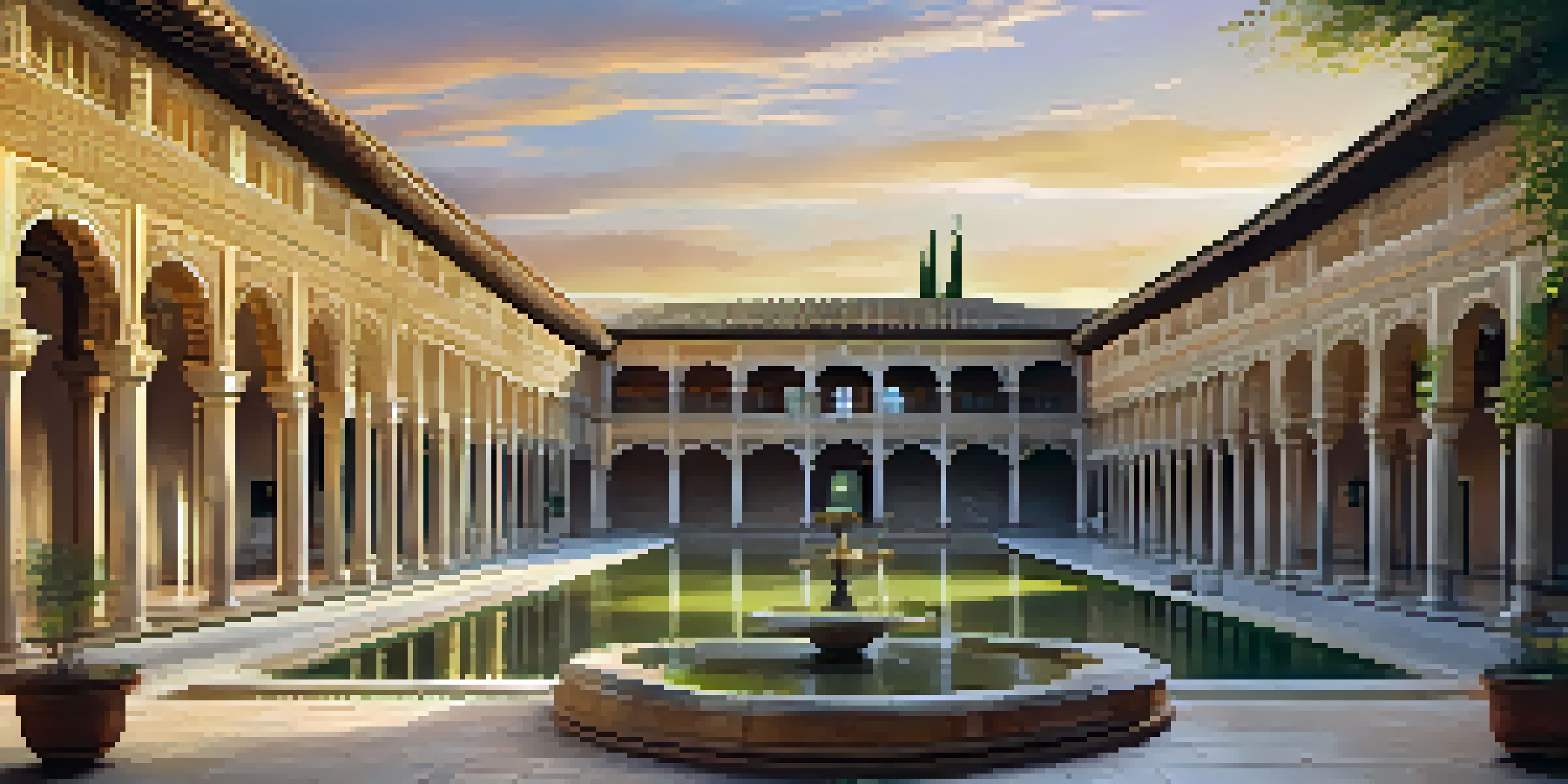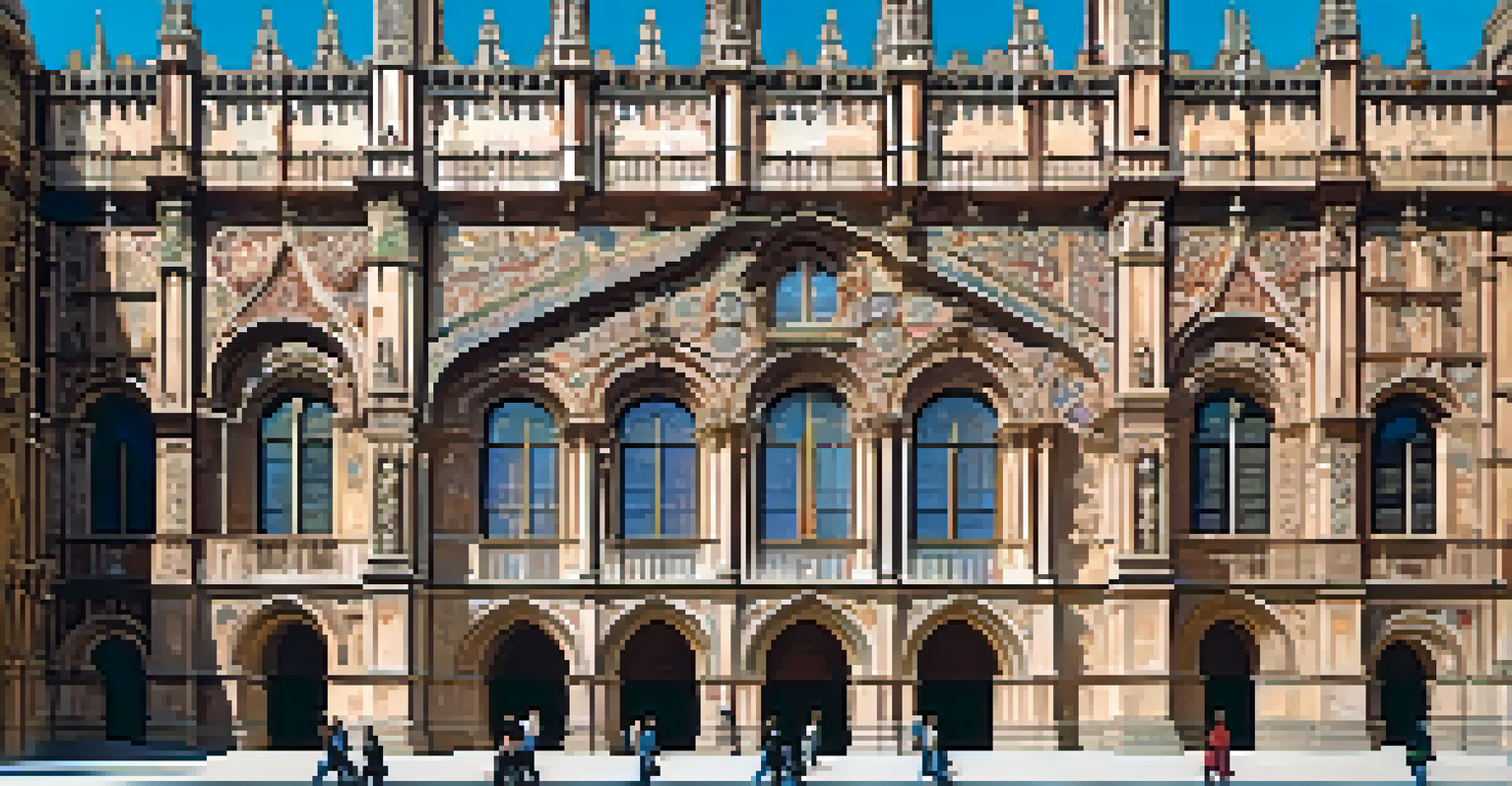Renaissance Architecture in Spain: A Cultural Revival

Understanding the Renaissance: A Brief Overview
The Renaissance was a vibrant period of cultural revival that began in Italy during the 14th century and spread throughout Europe. This era marked a renewed interest in classical art, literature, and philosophy, which significantly influenced architecture. Spain, in particular, became a canvas for this architectural transformation, blending traditional Gothic styles with the new Renaissance ideals.
Architecture is the learned game, correct and magnificent, of forms assembled in the light.
During the Renaissance, architects and artists sought to harmonize beauty with functionality, drawing inspiration from Ancient Greece and Rome. This shift was not just about aesthetics; it represented a broader cultural awakening that emphasized humanism and individual expression. As Spain engaged with these ideas, its architectural landscape began to evolve, reflecting the rich tapestry of its history and culture.
In Spain, this architectural shift was closely tied to the country's socio-political changes, including the unification of the kingdoms and the exploration of new territories. The Renaissance in Spain was not merely an import from Italy; it was adapted and infused with local traditions, creating a unique architectural identity that still resonates today.
Key Characteristics of Spanish Renaissance Architecture
Spanish Renaissance architecture is characterized by its grandiosity and intricate detail. One of the most notable features is the use of columns and pilasters, often adorned with elaborate carvings. These elements not only served structural purposes but also showcased the skill of the artisans and the wealth of the patrons funding the buildings.

Another defining characteristic is the incorporation of classical motifs, such as rounded arches and domes, which were inspired by Roman architecture. This blend of classical elements with local influences created a distinctive style that was both innovative and respectful of Spain's architectural heritage. The use of bright colors and decorative tiles also added a vibrant touch, setting Spanish Renaissance architecture apart.
Revival of Classical Ideals
The Renaissance sparked a renewed interest in classical art and architecture, blending these influences with local traditions in Spain.
Moreover, the layout of these buildings often emphasized symmetry and proportion, reflecting the Renaissance ideals of balance and harmony. This careful attention to design can be seen in numerous structures, from palaces to churches, where every detail contributes to an overall sense of beauty and purpose.
Notable Examples of Renaissance Architecture in Spain
One of the most iconic examples of Renaissance architecture in Spain is the Palacio de Carlos V in Granada. This palace, with its circular courtyard and grand façade, beautifully illustrates the merging of Spanish and Renaissance styles. It was built during the reign of Charles V, showcasing his ambition to create a lasting legacy in architecture.
Every building is a product of its time, and the architecture of the Renaissance represents the culmination of a cultural awakening.
Another remarkable structure is the University of Salamanca, renowned for its Plateresque style—a form of Spanish Renaissance architecture that incorporates elaborate decoration. The intricate stonework and ornate facades of this university reflect the intellectual spirit of the Renaissance, making it a vital center of learning and culture.
Additionally, the Cathedral of Toledo is a stunning example of how Gothic and Renaissance styles can coexist. While its original Gothic structure remains, Renaissance elements were added later, including the impressive altarpiece and various chapels, demonstrating the evolution of architectural styles throughout Spain's history.
The Influence of the Catholic Church on Renaissance Architecture
The Catholic Church played a pivotal role in the development of Renaissance architecture in Spain. As the primary patron of many architectural projects, the Church commissioned numerous cathedrals and religious buildings that reflected its power and influence. These structures were not only places of worship but also symbols of the Church's authority during a time of significant social change.
Churches such as the Jesuit Church of San Ignacio in Madrid exemplify the grandeur and ornamentation typical of this era. The use of light, space, and intricate altarpieces in these buildings aimed to inspire awe and devotion among congregants. The Renaissance focus on humanism also influenced religious art, making it more relatable and accessible to the public.
Church's Influence on Design
The Catholic Church was a major patron of Renaissance architecture in Spain, commissioning grand structures that reflected its authority and aimed to inspire devotion.
Furthermore, the Counter-Reformation movement prompted the Catholic Church to invest heavily in architecture to attract and retain followers. As a result, many Renaissance churches in Spain were designed to evoke emotional responses, utilizing dramatic lighting and elaborate decorations to enhance the spiritual experience of worshippers.
The Legacy of Renaissance Architecture in Spain
The legacy of Renaissance architecture in Spain is profound and enduring. This architectural style laid the groundwork for subsequent movements, including Baroque and Neoclassicism, which further transformed Spain's urban landscape. Many of the structures built during the Renaissance still stand today, serving as a testament to the creativity and ingenuity of Spanish architects and builders.
Renaissance architecture also left an indelible mark on Spanish culture, influencing everything from urban planning to interior design. The emphasis on symmetry, proportion, and classical elements can still be seen in modern Spanish architecture, demonstrating the lasting impact of this historic period.
Moreover, the Renaissance era fostered a greater appreciation for art and culture, encouraging future generations to explore and innovate. This cultural revival not only shaped Spain's architectural identity but also contributed to a broader European renaissance, highlighting Spain's role in the global narrative of art and architecture.
The Role of Urban Development in Renaissance Architecture
Urban development during the Renaissance was crucial to the proliferation of architectural projects across Spain. As cities grew and evolved, there was a pressing need for new buildings that could accommodate the changing social and economic landscape. This growth provided architects with opportunities to experiment with new styles and techniques, leading to a vibrant architectural scene.
Cities like Madrid and Seville became important centers for Renaissance architecture, with grand public squares and monumental buildings that reflected the aspirations of their citizens. The design of these urban spaces often took inspiration from classical ideals, creating harmonious environments that encouraged civic engagement and community interaction.
Legacy of Urban Development
Urban development during the Renaissance led to the creation of vibrant architectural scenes in cities like Madrid and Seville, balancing functionality with aesthetic beauty.
Additionally, the planning of urban areas during this time emphasized functionality and aesthetics, balancing the practical needs of the population with the desire for beauty. This careful planning has left a lasting impression on modern urban design in Spain, where many historical areas are preserved and celebrated as cultural heritage sites.
Conclusion: The Enduring Appeal of Renaissance Architecture
In conclusion, Renaissance architecture in Spain represents a remarkable fusion of cultural influences and artistic innovation. Its distinctive characteristics and historical significance make it a vital part of Spain's architectural heritage. As we explore these beautiful structures, we gain insights into the values, beliefs, and aspirations of a society undergoing profound transformation.
Today, Renaissance architecture continues to captivate visitors and locals alike, drawing admiration for its beauty and historical relevance. The preservation of these sites ensures that future generations can appreciate the artistry and craftsmanship that define this era.

Ultimately, the cultural revival of the Renaissance in Spain serves as a reminder of the power of creativity and collaboration in shaping our built environment. As we honor this architectural legacy, we celebrate not only the buildings themselves but also the rich history and vibrant culture that they represent.